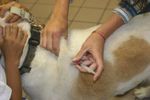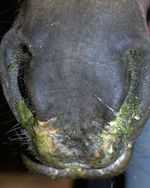Difference between revisions of "Vetstream Updates"
Ggaitskell (talk | contribs) |
Ggaitskell (talk | contribs) |
||
| (3 intermediate revisions by the same user not shown) | |||
| Line 1: | Line 1: | ||
| − | This month new content on Vetstream includes: | + | This month new content on Vetstream includes:[[File:Vetlexicon advert button.png|right|300px|link=https://www.vetstream.com/]] |
| Line 6: | Line 6: | ||
=== [https://www.vetstream.com/canis/Content/Freeform/fre00739.asp Diabetes mellitus management regimens] === | === [https://www.vetstream.com/canis/Content/Freeform/fre00739.asp Diabetes mellitus management regimens] === | ||
<br> | <br> | ||
| − | It is generally recommended that all insulin preparations should be administrated every 12 hours from the outset of the treatment. This will result in the greatest chance of success and lower insulin doses, and allows for a daily routine that is practical for most owners. | + | [[File:Thumbnail Diabetes mellitus management regimens - Canis.jpg|left|150px]]It is generally recommended that all insulin preparations should be administrated every 12 hours from the outset of the treatment. This will result in the greatest chance of success and lower insulin doses, and allows for a daily routine that is practical for most owners. |
This topic has been updated by Linda Fleeman BVSc PhD MANZCVS and Sarah Pierard BVSc PgCertVS MVS | This topic has been updated by Linda Fleeman BVSc PhD MANZCVS and Sarah Pierard BVSc PgCertVS MVS | ||
<br><br> | <br><br> | ||
| Line 17: | Line 17: | ||
=== [https://www.vetstream.com/canis/Content/Disease/dis00016.asp Sweat gland hyperplasia and neoplasia] === | === [https://www.vetstream.com/canis/Content/Disease/dis00016.asp Sweat gland hyperplasia and neoplasia] === | ||
<br> | <br> | ||
| − | Sweat gland tumors are uncommon, benign or malignant cysts and proliferations of sweat glands. Most arise from apocrine (epitrichial) sweat glands. Eccrine (atrichial) adenomas and adenocarcinomas are found on footpads. | + | [[File:Thumbnail Sweat gland hyperplasia and neoplasis - Felis.jpg|left|150px]]Sweat gland tumors are uncommon, benign or malignant cysts and proliferations of sweat glands. Most arise from apocrine (epitrichial) sweat glands. Eccrine (atrichial) adenomas and adenocarcinomas are found on footpads. |
This topic has been updated by David Godfrey BVetMed CertSAD CertSAM DipABVp (Feline practice) Cbiol FSB FRCVS | This topic has been updated by David Godfrey BVetMed CertSAD CertSAM DipABVp (Feline practice) Cbiol FSB FRCVS | ||
<br><br> | <br><br> | ||
| Line 29: | Line 29: | ||
=== [https://www.vetstream.com/lapis/Content/Freeform/fre00058.asp Analgesia] === | === [https://www.vetstream.com/lapis/Content/Freeform/fre00058.asp Analgesia] === | ||
<br> | <br> | ||
| − | Providing analgesia during and after procedures, especially surgical interventions, contributes to patient well-being and improved anesthesia outcome. It is important to give analgesics pre-emptively, as a more effective pain relief can be achieved (preventing ‘wind-up’). Dosage levels will depend on the size of the animal, the severity and type of pain, and the individual rabbit. | + | [[File:Thumbnail Analgesia - Lapis.jpg|left|150px]]Providing analgesia during and after procedures, especially surgical interventions, contributes to patient well-being and improved anesthesia outcome. It is important to give analgesics pre-emptively, as a more effective pain relief can be achieved (preventing ‘wind-up’). Dosage levels will depend on the size of the animal, the severity and type of pain, and the individual rabbit. |
This topic has been updated by Vicki Baldrey BSc(Hons) BVSc DipZooMed(Avian) MRCVS | This topic has been updated by Vicki Baldrey BSc(Hons) BVSc DipZooMed(Avian) MRCVS | ||
<br><br> | <br><br> | ||
| Line 42: | Line 42: | ||
<br> | <br> | ||
| − | Any disease leading to pharyngeal or esophageal dysphagia may lead to aspiration of food, water and saliva into the trachea and the rest of the respiratory tract, e.g. esophageal obstruction or choke. Neurological disorders and iatrogenic aspiration of material may also cause aspiration pneumonia. | + | [[File:Thumbnail Aspiration pneumonia - Equis.jpg|left|150px]]Any disease leading to pharyngeal or esophageal dysphagia may lead to aspiration of food, water and saliva into the trachea and the rest of the respiratory tract, e.g. esophageal obstruction or choke. Neurological disorders and iatrogenic aspiration of material may also cause aspiration pneumonia. |
This new topic has been written by Graham Munroe BVSc PhD DESM CertEO DipECVS FRCVS. | This new topic has been written by Graham Munroe BVSc PhD DESM CertEO DipECVS FRCVS. | ||
Latest revision as of 17:43, 28 September 2016
This month new content on Vetstream includes:
Canis
Diabetes mellitus management regimens
It is generally recommended that all insulin preparations should be administrated every 12 hours from the outset of the treatment. This will result in the greatest chance of success and lower insulin doses, and allows for a daily routine that is practical for most owners.
This topic has been updated by Linda Fleeman BVSc PhD MANZCVS and Sarah Pierard BVSc PgCertVS MVS
Felis
Sweat gland hyperplasia and neoplasia
Sweat gland tumors are uncommon, benign or malignant cysts and proliferations of sweat glands. Most arise from apocrine (epitrichial) sweat glands. Eccrine (atrichial) adenomas and adenocarcinomas are found on footpads.
This topic has been updated by David Godfrey BVetMed CertSAD CertSAM DipABVp (Feline practice) Cbiol FSB FRCVS
Lapis
Analgesia
Providing analgesia during and after procedures, especially surgical interventions, contributes to patient well-being and improved anesthesia outcome. It is important to give analgesics pre-emptively, as a more effective pain relief can be achieved (preventing ‘wind-up’). Dosage levels will depend on the size of the animal, the severity and type of pain, and the individual rabbit.
This topic has been updated by Vicki Baldrey BSc(Hons) BVSc DipZooMed(Avian) MRCVS
Equis
Aspiration pneumonia
Any disease leading to pharyngeal or esophageal dysphagia may lead to aspiration of food, water and saliva into the trachea and the rest of the respiratory tract, e.g. esophageal obstruction or choke. Neurological disorders and iatrogenic aspiration of material may also cause aspiration pneumonia.
This new topic has been written by Graham Munroe BVSc PhD DESM CertEO DipECVS FRCVS.



